Dinner – for the Birds
go.ncsu.edu/readext?750314
en Español / em Português
El inglés es el idioma de control de esta página. En la medida en que haya algún conflicto entre la traducción al inglés y la traducción, el inglés prevalece.
Al hacer clic en el enlace de traducción se activa un servicio de traducción gratuito para convertir la página al español. Al igual que con cualquier traducción por Internet, la conversión no es sensible al contexto y puede que no traduzca el texto en su significado original. NC State Extension no garantiza la exactitud del texto traducido. Por favor, tenga en cuenta que algunas aplicaciones y/o servicios pueden no funcionar como se espera cuando se traducen.
Português
Inglês é o idioma de controle desta página. Na medida que haja algum conflito entre o texto original em Inglês e a tradução, o Inglês prevalece.
Ao clicar no link de tradução, um serviço gratuito de tradução será ativado para converter a página para o Português. Como em qualquer tradução pela internet, a conversão não é sensivel ao contexto e pode não ocorrer a tradução para o significado orginal. O serviço de Extensão da Carolina do Norte (NC State Extension) não garante a exatidão do texto traduzido. Por favor, observe que algumas funções ou serviços podem não funcionar como esperado após a tradução.
English
English is the controlling language of this page. To the extent there is any conflict between the English text and the translation, English controls.
Clicking on the translation link activates a free translation service to convert the page to Spanish. As with any Internet translation, the conversion is not context-sensitive and may not translate the text to its original meaning. NC State Extension does not guarantee the accuracy of the translated text. Please note that some applications and/or services may not function as expected when translated.
Collapse ▲Southern gardeners have long been known for their generosity in making sure that our feathered friends have ample food during the winter months. Most yards have a trusty bird feeder that is kept full of birdseed. But, wouldn’t it be nice to have some supplemental and sustainable sources of food for our winter friends? A little planning and planting can make a huge impact on the supply of winter food for area birds. Not all birds migrate south for the winter and those that stick around appreciate the thoughtful addition of plants that can give them some much needed nourishment as well as shelter. Take a look at these plants and consider adding some to your landscape.
American Bittersweet, Celastrus scandens, not to be confused with the invasive oriental bittersweet is a great choice for both shelter and food for local birds. This large shrub offers orange berries and dense branches throughout the winter. But, be aware that one male plant is needed for every five female plants if berries are desired.
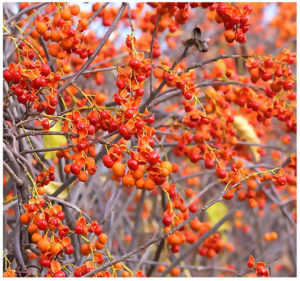
American Bittersweet
American Cranberry viburnum, Viburnum trilobum is not only a great landscape shrub but also a wonderful source of winter nourishment with red berries that last throughout the winter.
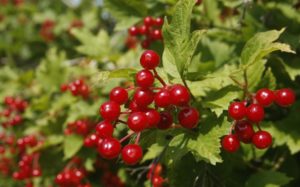
American Cranberry
Arborvitae, Thuja occidentalis offers many cultivars of all sizes that will fit any landscape. Its small seeded cones offer winter feeding opportunities all winter.
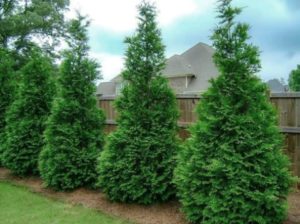
Arborvitae
Beautyberry, Callicarpa species is a winter favorite of both wildlife and gardeners with its brilliant clusters of fuchsia colored berries for not only winter color but also “winter dinner”. There are also white berried cultivars available.

Beautyberry
Blue Spruce , Picea pungens is a common choice for Burke County gardeners. Its beautiful blue winter tinge gives the winter landscape a pop of color while its dense needles and branches give shelter during the cold winter months as well as providing food from it seed-bearing cones.
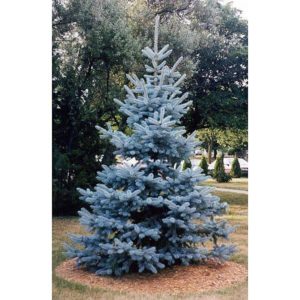
Blue Spruce
Pyracantha, Pyracantha coccinea has long been used as both a landscape plant and a source of wildlife food with its bright orange or red berries lasting most of the winter.
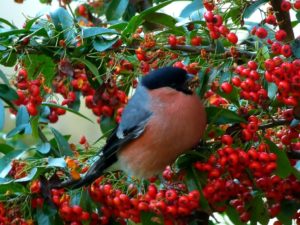
Pyracantha
Serviceberry, Amalanchier species is a native tree that grows well in Burke County and is a great source of winter food with its bountiful crop of winter fruit.

Serviceberry
Holly, Ilex cornuta with its multitude of cultivars is by far the most often planted source of winter food. Bright red berries abound throughout the winter and there is sure to be a holly that will fit into your winter landscape.

Holly
Sumac, Rhus species offers both native and hybrid cultivars for winter consumption. Their spikes of bright red fruit are a very nutritious food source for winter wildlife.
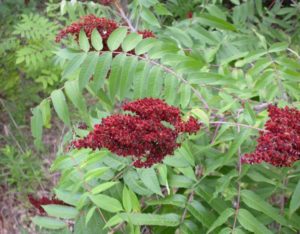
Sumac
Winterberry, Ilex verticillate, my personal favorite, is one of the most brilliant of all winter shrubs. Dropping its leaves at frost this shrub has never-ending clusters of red berries that stand out against the winter landscape.
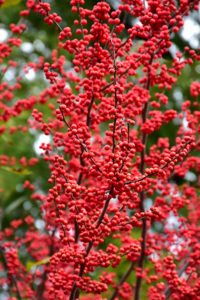
Winterberry
As I see it, it’s a win-win scenario for everyone: The gardener gets some great landscape plants that give a free, winter-long supply of food and shelter to our winged wildlife. The landscape has nice winter color and the birds will come through the winter happy and healthy to live and sing for us in our gardens another day. A free concert!




